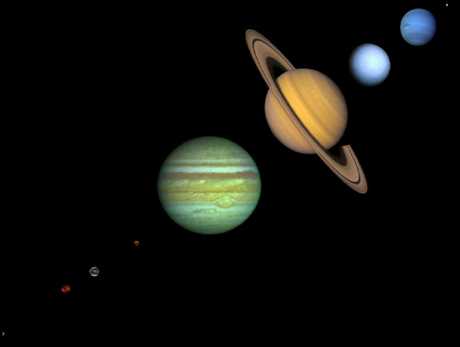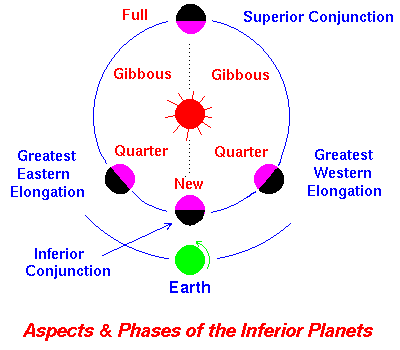 Phases of the Moon, Aspects and Phases of Planets
Phases of the Moon, Aspects and Phases of Planets
Introduction
"Phase" refers
to the fact that the moon shows differing
amounts of lighted hemispheres as viewed from the earth during its
orbit around the earth.
"Cycle" refers to the repetition of these phases, as well as cycles
of eclipses. We will investigate these here.
Understanding the observed phases of the moon, requires understanding
how light and shadowing works in relation to the sun's light and the
orbit of the moon and earth around the sun.
A superstition:
It is sometimes believed that when the moon is bright and full, people act crazy. In fact, there is no statistical scientific
evidence to support this. It is a myth.
Also: note that there are no monsters devouring the sun, as you might
have been told if you were listening to a professor in 2000 BC.
One thing about studying moon phases: it begins to address
specifically how what we see observe in astronomy
has a very clear scientific explanation.
Motion of the Moon
First note that if you watch the moon night after night,
you will see two key features which are fundamental clues
to understanding its motion:
- It moves eastward against the background stars.
- It shows same face toward Earth in all phases.
Given these facts, can you infer if the moon rotates around its own axis?
(figure 3-2)
Other Key Points:
The moon orbits quite fast: it moves about 0.5 degrees per hour in the sky.
In 24 hours it moves 13 degrees.
The moon's observed motion eastward results from its physical motion
of the moon along its orbit around the Earth.
The distance from the Earth to the moon is about 30 times the Earth's
radius.
The moon orbits counterclockwise around the Earth.
Orbit is slightly elliptical and distance from Earth varies 6 %.
Period of the orbit is about 27.3 days. This is called the
SIDERIAL PERIOD. This is measured with respect to the background stars:
the moon takes 1 sidereal period to cycle around once.
In its eastward motion, the moon stays near the ecliptic.
(recall, this is the plane of the sun's motion on the sky).
It is tipped by 5 degrees 9' (5 degrees 9 arc seconds) to the
plane of the Earth's orbit around the sun and this tilted to
ecliptic by same amount.
This means that the moon also appears to trace the Zodiac
along the sky since its deviation from the ecliptic plane on
the sky as it orbits is so small.
The Phase Cycle of the Moon
Moon does not produce its own light, and so the light that we see
from it is that which is merely reflected from the sun.
As the moon moves around the sky sun illuminates different amounts
of its surface. The phase of the moon is thus entirely determined by
looking at the Earth's location relative to the sun.
(figure 3-3).
The best way to see the phases is to study the figure.
One can see the progression of phases:
New, Waxing Crescent, First quarter, waxing gibbous, full,
waning gibbous, 3rd quarter, waning crescent.
Note: the use of the word "quarter" here does not refer to how
much of the moon is visible, but the phase in the cycle.
Cycle of lunar phases takes 29.5 days this is the SYNODIC PERIOD.
Why is this longer than the SIDERIAL PERIOD which was 27.3 days?
very simple: this is because the moon returns to the same
place on the sky once every siderial period, but the sun is
also moving on the sky. When the moon returns to the same
spot on the sky the sun has moved 27 degrees. Thus the moon now has
to take some extra time to catch up.
(figure 3-4). The moon takes about 2 days to catch up.
The conceptual way to understand moonrise and moonset from the
book is to follow the directions in the book on how to make a moon-phase
dial.
Imagine standing with the human figure on the globe pictured.
Now the key point is that the horizon above which the moon is
visible, is the plane perpendicular to your body. The time
of the day is given by "sunrise, sunset, noon, midnight."
Those times of day appear to us as the Earth rotates so that the US
passes through them. While the Earth rotates, the position of the moon
in its orbit doesnt change much, so we can talk about moonrise and moonset.
As you imagine the Earth turning and the various times of day
passing you can see how the moonrise and moonset differs for different
moon phases.
The Tides
If you live near the sea or you surf you are familiar with the tides and the
periodic high and low tides.
Then pick a particular phase of the moon.
The planets, as viewed in the sky, exhibit characteristic aspects and
phases. "Aspects" refers to the location of the planet with respect tour overhead sky reference (objects on the celestial sphere);
"Phase" again refers
to the fact that the planets, through a telescope, exhibit phases (differing
amounts of lighted hemispheres as viewed from the earth) just like the moon.
The terminology
associated with these aspects and phases is different, depending on whether we
refer to an inferior planet or a superior planet.
Aspects and Phases of the Inferior Planets
The inferior planets exhibit the aspects and phases illustrated in the
following diagram.

Gibbous phases are phases between quarter and full phases. Greatest
Elongation refers
to the largest separation of the planet from the Sun in our sky, either to the
East, or to the West.
Thus, we see that the inferior planets exhibit a complete set of phases (just
like the Moon) as viewed from the earth, and can never be further from the Sun
than the angles defined by greatest elongation.
Aspects and phases of the
inferior planets.
Aspects and Phases of the Superior Planets
The aspects and phases of the superior planets differ from those of the
inferior planets because of geometry: their orbits are outside that of the
Earth. These aspects and phases
are indicated in the following diagram.

When a superior planet is at quadrature, it is on our celestial meridian at
sunrise or sunset. Comparing with the preceding diagram for the inferior
planets, we notice two basic differences: (1) The superior planets do not
exhibit a full range of phases; they are always gibbous or full. (2) The
superior planets can be located at any distance East or West of the Sun in our
sky, unlike the inferior planets where there is a limiting angle away from the
Sun (greatest elongation).
Shockwave
movie illustrating aspects and phases of the
superior planets.
Next
Back


 Phases of the Moon, Aspects and Phases of Planets
Phases of the Moon, Aspects and Phases of Planets